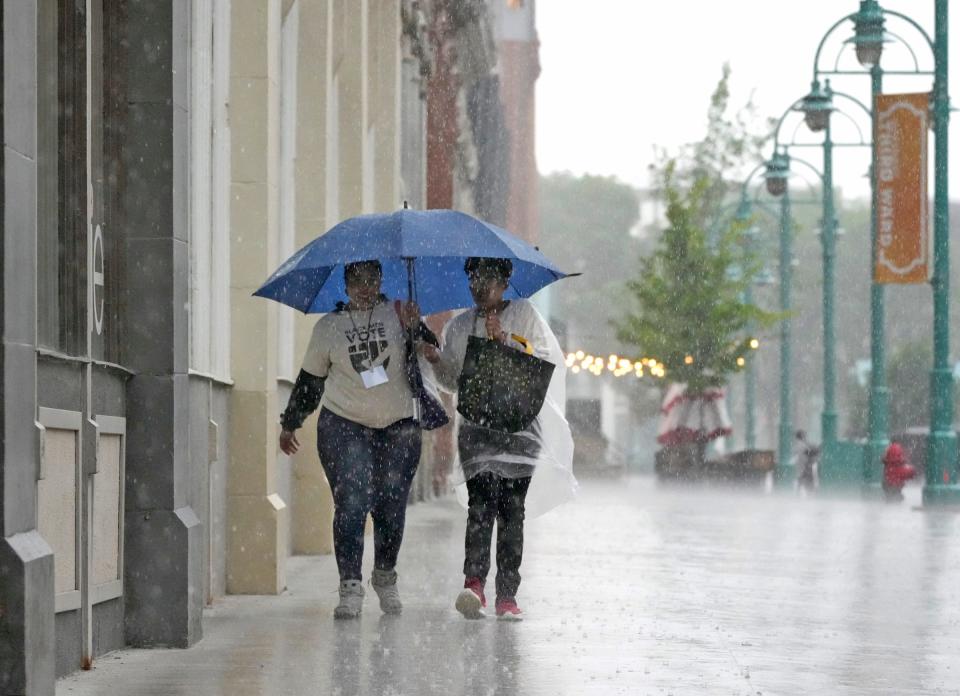Rain has pummeled Milwaukee so far this spring. Why haven't there been more sewer overflows?
Rainfall pounding off the city pavement has been one of the most common sights for Milwaukeeans so far this spring.
Milwaukee has received more than 15 inches of rain since March 1, according to data from the National Weather Service. It may come as a surprise to many that the rainier-than-average spring, and one of the city's rainiest on record, hasn't led to more combined sewer overflows.
So, what happened — or, more specifically, didn't happen?
There are a lot of variables that lead to overflows, and one of the biggest is rainfall intensity, said Bill Graffin, public information manager at the Milwaukee Metropolitan Sewerage District. While there has been a lot of rain, it has been drawn out, Graffin said. Other related factors include ground saturation and the rate of flow into the system.

In other words, a light all-day rain is easier to handle than an overwhelming two-hour downpour.
That isn't to say the system wasn't stretched, Graffin said. But there wasn't a risk of overflows during the last few storms.
For background, Milwaukee has a combined sewer system, which means that both stormwater and wastewater from homes and businesses flow through the same pipes before being treated by the sewerage district. The district serves 1.1 million people across 28 communities, which involves the city of Milwaukee and many surrounding suburbs.
When one inch of rain falls on the service area, that means the sewerage district must treat more than 7 billion gallons of water entering the combined sewer system. If more water enters the deep tunnel than can be processed during a heavy storm, the sewerage district can initiate an overflow, releasing untreated wastewater into local waterways to prevent sewage from backing up into homes and businesses.
A combined sewer overflow is like opening a relief valve, Graffin said, because the biggest priority is to prevent sewage backups.
By federal law, the sewerage district is allowed six overflows per year.
In determining whether an overflow must happen, Graffin said, the sewerage district pays close attention to the radar and forecasts.
One sewer overflow has happened so far this year, and it was in April. The overflow lasted 50 hours after an average of 1.7 inches of rain fell on already saturated ground, which led to the release of 357 million gallons of untreated wastewater into local waterbodies, and in turn Lake Michigan.
Most of the water that's released is rainwater that flows out of the system as soon as it rushes in. There is, however, a risk that untreated sewage is also released, so residents are often advised to avoid the impacted waterbodies. Lake Michigan's conditions are pretty harsh, so bacteria can usually only survive up to 10 days.
Graffin said that the combined sewer system captures a lot of pollution and treats it before there is an overflow, and overflows are much less polluted than they were decades ago.
One element helping the sewer system is the city's green infrastructure. It plays a big role in capturing rain where it falls and storing it, which in turn protects against flooding and excessive heat as well as improves air, soil and water quality. This will help the city better adapt to a changing climate and the heavier storms to come.
Currently, green infrastructure around the service area can capture 144 million gallons of water. As more green infrastructure is built, it should hold exponentially more gallons of water.
Residents can also help by reducing water use during heavy rain events. That means taking shorter showers, saving laundry and dishes for another day, and emptying rain barrels regularly. To receive updates on when overflows happen, text WATERDROP to 414-296-4422.
Milwaukee's sewerage district has captured and cleaned an average of 98.6% of wastewater over the past three decades.
"The more help we can get in catching water where it falls, the better fishing, swimming and water quality we will have," Graffin said. "That's the goal."
More: Milwaukee is turning around one of the most degraded sites in the Great Lakes. Here's how.
More: Milwaukee's rivers were once open sewers to Lake Michigan. Here's how they're being cleaned up.
Caitlin Looby is a Report for America corps member who writes about the environment and the Great Lakes. Reach her at clooby@gannett.com or follow her on X @caitlooby.
This article originally appeared on Milwaukee Journal Sentinel: With all the spring rain, why has there been only one sewer overflow?

